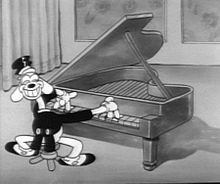Goopy Geer (film): Difference between revisions
add reception |
m →External links: recat |
||
| (2 intermediate revisions by one other user not shown) | |||
| Line 50: | Line 50: | ||
[[Category:1932 films]] |
[[Category:1932 films]] |
||
| ⚫ | |||
| ⚫ | |||
[[Category:Animated films about dogs]] |
[[Category:Animated films about dogs]] |
||
[[Category:Films scored by Frank Marsales]] |
[[Category:Films scored by Frank Marsales]] |
||
| Line 59: | Line 57: | ||
[[Category:Warner Bros. Cartoons animated short films]] |
[[Category:Warner Bros. Cartoons animated short films]] |
||
[[Category:1930s Warner Bros. animated short films]] |
[[Category:1930s Warner Bros. animated short films]] |
||
| ⚫ | |||
| ⚫ | |||
Latest revision as of 03:57, 3 December 2024
| Goopy Geer | |
|---|---|
 Goopy Geer playing the piano. | |
| Directed by | Rudolf Ising |
| Produced by | Hugh Harman Rudolf Ising Leon Schlesinger |
| Starring | Johnny Murray Rudolf Ising The King's Men |
| Music by | Frank Marsales |
| Animation by | Isadore Freleng Rollin Hamilton Uncredited: Bob Clampett Paul J. Smith Larry Martin Norman Blackburn Carman Maxwell |
| Layouts by | Isadore Freleng (uncredited) |
| Backgrounds by | Art Loomer (uncredited) |
| Color process | Black-and-white |
Production company | |
| Distributed by | Warner Bros. Pictures The Vitaphone Corporation |
Release date |
|
Running time | 7 minutes |
| Language | English |
Goopy Geer is a 1932 Warner Bros. Merrie Melodies cartoon short directed by Rudolf Ising, featuring the first appearance of the title character.[1] The short was released on April 16, 1932, alongside the feature film The Crowd Roars.[2]
Synopsis
[edit]The customers in a nightclub clamor for Goopy Geer, who then comes out on the stage and entertains them by playing the piano, first with his fingers and his ears, later with his animated gloves. He's soon accompanied by a girl who tells a joke and sings a song.
Meanwhile, the customers eat and carry on in slapstick ways, and two coat racks dance together.
Toward the end, a drunken horse spits fire and destroys the piano, but Goopy keeps right on playing.
Notes
[edit]- Two scenes—one involving a waiter, the other the drunken horse—are reused from the earlier Foxy short Lady, Play Your Mandolin! Also, one of the customers, a fat lady hippo, had also appeared in a Foxy short, Smile, Darn Ya, Smile!
Reception
[edit]Motion Picture Herald called the film "an amusing cartoon number." The review noted that "the furniture does its assorted jigging in a manner often done before, but the short is entertaining enough in animated fashion."[3]
References
[edit]- ^ Beck, Jerry; Friedwald, Will (1989). Looney Tunes and Merrie Melodies: A Complete Illustrated Guide to the Warner Bros. Cartoons. Henry Holt and Co. p. 10. ISBN 0-8050-0894-2.
- ^ Lenburg, Jeff (1999). The Encyclopedia of Animated Cartoons. Checkmark Books. pp. 104–106. ISBN 0-8160-3831-7. Retrieved June 6, 2020.
- ^ "Shorts". Motion Picture Herald. 107 (5): 42. April 30, 1932. Retrieved February 19, 2024.
External links
[edit]- Goopy Geer at IMDb
- Goopy Geer at the TCM Movie Database
- Goopy Geer on YouTube
- 1932 films
- Animated films about dogs
- Films scored by Frank Marsales
- Animated films about music and musicians
- Films directed by Rudolf Ising
- Merrie Melodies short films
- Warner Bros. Cartoons animated short films
- 1930s Warner Bros. animated short films
- American animated black-and-white films
- 1932 animated short films
- Merrie Melodies stubs
